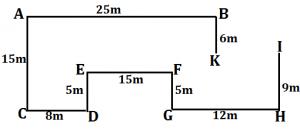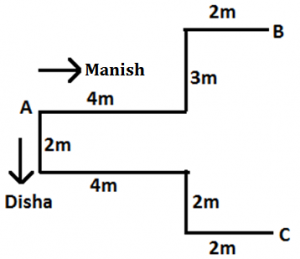Direction (1-3): Study the following information carefully and answer the given questions:
Point A is 25m west of point B which is 6m north K. Point H is 9m south point I. Point G is 5m south of point F which is 15m east E. Point C is 15m south of point A. Point H is 12m east of point G. Point E is 5m north of point D which is 8m east of point C.
Q1. What is direction of point A with respect to point I?
(a) West
(b) North-east
(c) South
(d) North-West
(e) None of these
Q2. What is the distance between point K and point I?
(a) 11m
(b) 10m
(c) 15m
(d) 12m
(e) None of these
Q3. What is the direction of point G with respect to point E?
(a) South-east
(b) West
(c) South
(d) South-west
(e) None of these
Directions (4-5): Read the following information carefully and answer the questions which follow.
Manish who is facing North, starts from point A, walks 4 m towards the right. He then takes a left turn and walks 3 m before taking a right turn, walking 2 m and stopping at point B. Disha starts from the same point A walks 2 m towards the South. She then takes a left turn and walks 4 m. She now takes a right turn, walks 2 m and then take a left turn and walks 2 m and stopped at point C.
Q4. What is distance between point B and point C ?
(a) 5 m
(b) 8 m
(c) 7 m
(d) 6 m
(e) 9 m
Q5. If Disha walks 4 m towards North from Point C, how far will she be from Point A ?
(a) 4 m
(b) 2 m
(c) 6 m
(d) 8 m
(e) 7 m
Directions (6–10): Study the following information carefully and answer the questions given below.
Give answer-
(a) If only conclusion I is true
(b) If only conclusion II is true
(c) If either conclusion I or conclusion II is true
(d) If neither conclusion I nor conclusion II is true
(e) If both conclusions I and II are true
Q6. Statements: H = W, R > F, W ≤ R, F>S,
Conclusions: I. R > H
II. R > S
Q7. Statements: T > K, D ≥ K, M > T
Conclusions: I. D < M
II. M ≥ D
Q8. Statements: R ≤N, F > B, N ≥F
Conclusions: I. N > B
II. B ≤ R
Q9. Statements: H > W, M ≥K, W > M
Conclusions: I. W > K
II. H ≤ M
Q10. Statements: R ≥T, M > D≥Q, T = M,
Conclusions: I. Q < R
II. R ≥ M
Directions (11-15): In these questions, a relationship between different elements is shown in the statements. The statements are followed by two conclusions. Give answer
Q11. Statement: L≤T≤I, M>I<X, P≤T≥B
Conclusions: I. B<X
II. X>M
(a) if only conclusion II is true.
(b) if only conclusion I is true.
(c) if neither conclusion I nor II is true.
(d) if either conclusion I or II is true.
(e) if both conclusions I and II are true.
Q12. Statement: Z<U≤D, A≤U≤M<S, Q>M≤Y<G
Conclusions: I. Z<Y
II. S>Q
(a) if both conclusion I and II are true.
(b) if only conclusion I is true.
(c) if neither conclusion I nor II is true.
(d) if either conclusion I or II is true.
(e) if only conclusion II is true.
Q13. Statement: N≤T≤I, M>B<X, W<T≤L≥B≥K
Conclusions: I. K≤I
II. I<K
(a) if only conclusion II is true.
(b) if either conclusion I or II is true.
(c) if neither conclusion I nor II is true.
(d) if only conclusion I is true.
(e) if both conclusions I and II are true.
Q14. Statement: L≤T≤I, M>I<X, P≤T≥B
Conclusions: I. M≥P
II. X>L
(a) if only conclusion II is true.
(b) if only conclusion I is true.
(c) if neither conclusion I nor II is true.
(d) if either conclusion I or II is true.
(e) if both conclusions I and II are true.
Q15. Statement: Z<U≤D, A≤U≤M<S, Q>M≤Y<G
Conclusions: I. D>S
II. S≤D
(a) if only conclusion II is true.
(b) if either conclusion I or II is true.
(c) if neither conclusion I nor II is true.
(d) if only conclusion I is true.
(e) if both conclusions I and II are true.
Solutions
Solutions (1-3):
Sol.

S1. Ans. (d)
S2. Ans. (b)
S3. Ans. (a)
Solutions (4-5):
Sol.

S4. Ans. (c)
S5. Ans. (c)
S6. Ans. (b)
Sol. I. R > H (false)
II. R > S (true)
S7. Ans. (d)
Sol. I. D < M (false)
II. M ≥ D (false)
S8. Ans. (a)
Sol. I. N > B(true)
II. B ≤ R (false)
S9. Ans. (a)
Sol. I. W > K (true)
II. H ≤ M (false)
S10. Ans. (e)
Sol. I. Q < R (true)
II. R ≥ M (true)
S11. Ans. (b)
S12. Ans. (b)
S13. Ans. (b)
S14. Ans. (a)
S15. Ans. (c)





 GA Capsule for SBI Clerk Mains 2025, Dow...
GA Capsule for SBI Clerk Mains 2025, Dow...
 The Hindu Review October 2022: Download ...
The Hindu Review October 2022: Download ...
 FCI Recruitment 2025 Notification Out So...
FCI Recruitment 2025 Notification Out So...





